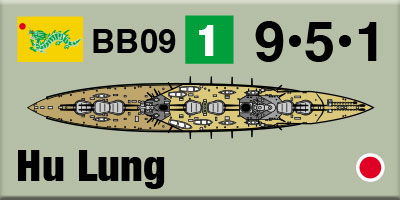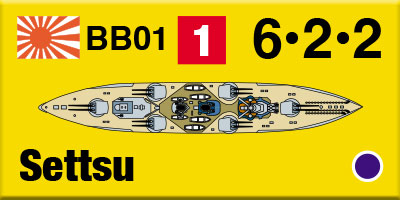Rise of the Dragon:
Publisher’s Preview
by Mike Bennighof, Ph.D.
December 2023
 Rise of the Dragon is an expansion for Great War at Sea: Russo-Japanese War, one based on a fleet that never existed fighting a war that never happened. In other words, it’s a fairly standard Avalanche Press alt.history production. Rise of the Dragon is an expansion for Great War at Sea: Russo-Japanese War, one based on a fleet that never existed fighting a war that never happened. In other words, it’s a fairly standard Avalanche Press alt.history production.
In 1907, Chinese regent Prince Chun Zaifeng accepted a proposal to build a modern dreadnought fleet to defend China from expected Japanese aggression in the wake of the Russo-Japanese War. The Chinese toured shipyards in Europe, Japan and the United States and placed a few small orders, but the dreadnought fleet proposal could not overcome the corruption and inertia endemic to the Empire in its last years.
That’s not the case in Rise of the Dragon, where we can bring that fleet to cardboard reality and send it into battle against the Japanese, as Prince Chun intended. It’s got 155 pieces, with Chinese, Japanese and American ships, and a set of 41 scenarios telling the story of this war in two phases. First there’s a prelude, in which the Chinese teach the Russians that this isn’t their fathers’ China. Next, the Japanese beat up on the Chinese, and then the Americans intervene to put this naval war on a more even keel. It all takes place on the map from Russo-Japanese War, which conveniently includes a slice of northern China.
Now that we’ve released the Second Edition of Great War at Sea’s series rules, and a new edition of Russo-Japanese War to make use of them, Rise of the Dragon needs the same treatment. That was an excuse to re-make the book from stem to stern.

I like for our books to be split between story and game stuff in rough balance. Rise of the Dragon meets that, almost to the letter, since we pick up some extra real estate in the Second Edition: many of what were once Special Rules are now embodied in the Second Edition Series Rules. I used that to add a few more scenarios, because I could.
Rise of the Dragon’s prior edition also included the Advanced Dreadnought Leader optional tactical rules, by Karl Laskas and Bob Titran. These give you many more options for the Naval Tactical Map, with things like formation, arcs of fire, lines of battle, crossing the T, smokescreens and much more. Those have been superseded by the Second Edition series rules, along with an updated version of the very simple quick-play tactical system. That lets you play with more intensity, or less, as you choose. It also gave me, the designer/author, another nine pages to play with.

As much as I liked the prior edition of Rise of the Dragon, the story part wasn’t as smoothly integrated with the game-play, the way our later books have bene structured – we’ve gotten better at it with practice. And all that extra space to play with just made it seem natural to build up the story of the War of the Dragons, the 1915 conflict between Japan and China that never happened but is the background for our game.

China’s investment has yielded a fleet of eighteen battleships: nine dreadnoughts and nine pre-dreadnoughts. They also have four armored cruisers and sixteen light cruisers, as Prince Chun’s program directed. And there are gunboats, destroyers, and torpedo boats – these weren’t mentioned in the 1907 program and its 1909 revision, but orders were actually placed for some of the destroyers so these boats would definitely have been part of the program. Given the pattern of Chinese military purchases before the Revolution ended the imperial government (and afterwards, for that matter), these have been spread across shipyards around the world, mostly in order to provide more kickbacks for the program’s overseers (and if that seems cynical, it’s exactly how the Empire operated before its fall, and the Republic during its existence).
The dreadnoughts and cruisers come from Germany, Austria-Hungary (a major recipient of actual Chinese orders), Japan and Britain. Existing warships have been purchased from Brazil and Britain. Manning such a fleet would have required a massive training program, and it’s assumed that a large number of foreign “contractors” would have to be employed (most of them American, given the ongoing war in Europe).

Since the ships are built in foreign yards, the extend of the program is readily evident in Tokyo and sparks a reaction. The prizes taken from the Russians in 1904 and 1905 are not re-constructed, a major waste of money and resources in our own history (and proof that endemic corruption was not a Chinese monopoly). Instead, those have gone to building new ships, and Japan fields a much stronger fleet than she had in our own 1915.
It's a strong enough fleet, manned by well-trained crews, to put a beating on the Chinese. And that eventually sparks American intervention. The Americans show up with five battleships (all of them actually built) plus two more purchased from Argentina (which did not actually happen, but the U.S. Navy had an option to do so), and two battle cruisers based on the 1910 design for a well-protected but relatively lightly-armed ship, and of course supporting cruisers and destroyers. They arrive to support the Chinese, but things don’t go quite as planned in Washington but the American seizure of Okinawa is enough to convince the Japanese to make peace.

One of the great benefits of alternative-history game design is that you, the designer, get to craft the story to fit the game you want to build, rather than the other way around. And so Rise of the Dragon includes plenty of mass-battleship-action battles as well as cruiser raids, amphibious assaults and convoy actions.
The War of the Dragons fits the sort of alternative-history turning point I like to weave into these narratives, one decision or event that actually could have turned out differently. Societies move slowly and deliberately, and a different outcome of X battle or Y election rarely has the decisive impact that may seem obvious at first glance. We are stretching a little in this alternative: Imperial China could still generate a good deal of government revenue in 1907 and could have afforded a dreadnought fleet, and had made steps toward building the infrastructure necessary to man and support the big ships. To complete that project, and put that fleet to use to defend Chinese independence from the Japanese, would have required a society-wide commitment. Signs of that appeared and helped drive the revolution of 1911; we’ve posited that the Imperial government not only spent its money wisely but also managed to harness growing Chinese patriotism into effective movement. And then lost, because the good guys don’t always win.

As re-constructed, Rise of the Dragon meets all of our requirements for a good expansion book: it draws on just one game, it tells a compelling story driven by good scenarios, and it includes nice components.
You can order Rise of the Dragon (second edition) right here.
Prince Chun’s Dreadnoughts
Russo-Japanese War (Playbook)
Rise of the Dragon (2e)
Retail Price: $99.98
Package Price: $80.00
Gold Club Price: $64.00
You can order Prince Chun right here.
Sign up for our newsletter right here. Your info will never be sold or transferred; we'll just use it to update you on new games and new offers.
Mike Bennighof is president of Avalanche Press and holds a doctorate in history from Emory University. A Fulbright Scholar and NASA Journalist in Space finalist, he has published a great many books, games and articles on historical subjects; people are saying that some of them are actually good.
He lives in Birmingham, Alabama with his wife, three children, and his new puppy. His Iron Dog, Leopold, could swim very well.
Want to keep Daily Content free of third-party ads? You can send us some love (and cash) through this link right here.
|
